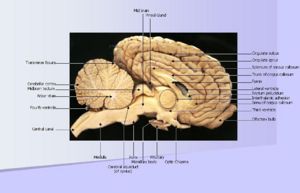Nervous and Special Senses - Anatomy & Physiology
Nervous System
The physiology of the nervous system can be explored at the level of a nerve cell, or 'neuron'. Communication between these cells uses electrical or chemical signals known as neurotransmitters; the cellular response generated in response to this signalling is known as an action potential.
Central Nervous System (CNS)
The central nervous system is comprised of the brain and spinal cord. The brain is contained within the skull, and the spinal cord is contained within the spinal vertebral canal. The brain is covered and protected by the meninges. The meninges are comprised of three layers: the dura mater (the outermost layer), the arachnoid mater (the middle layer), and the pia mater (the innermost layer). Cerebral Spinal Fluid (CSF) is the fluid surrounding the brain as well as the central canal of the spinal cord which helps cushion the CNS, acts as a chemical buffer, provides immunological protection and transports waste products and nutrients. Nerves arising from the brain and brain stem are the cranial nerves whilst those arising from the spinal cord are the peripheral nerves.
Peripheral Nervous System (PNS)
The Peripheral Nervous System includes both cranial nerves and spinal nerves, and is commonly divided into the somatic nervous system and the autonomic nervous system. The somatic nervous system co-ordinates body movements and also receives external stimuli. It basically regulates activities that are under conscious control. The autonomic nervous system contains the sympathetic nervous system and the parasympathetic nervous system as well as an enteric division. The sympathetic nervous system is the ‘fight or flight’ system which is triggered when an animal is under threat; it's main neurotransmitter is adrenaline. The parasympathetic nervous system is the ‘rest and digest’ system which is responsible for digestion; the primary neurotransmitter is acetylcholine. Further information on the structure, physiology and pathology of the PNS is available from the following links:
Information Pathways
In physiological terms, when processing information the CNS and PNS are integrated into pathways; examples would include motor pathways and sensory pathways. Motor pathways carry signals from the cerebellum to the skeletal muscles using upper and lower motor neurons connected via the pyramidal system or the extrapyramidal system. Sensory pathways carry sensory information detected by peripheral nerves in an ascending path through the spinal cord to the higher levels of the brain. Types of general somatic sensation include pain, touch, temperature and kinaesthesia (conscious proprioception).
Special Senses
In anatomy, there are four major senses which have specialised organs assocated with them. They are the eye, the ear, the nose and the tongue. These organs process visual, auditory, olfactory and taste sensations respectively.
| Nervous and Special Senses - Anatomy & Physiology Learning Resources | |
|---|---|
To reach the Vetstream content, please select |
Canis, Felis, Lapis or Equis |
 Test your knowledge using flashcard type questions |
Sensory Pathways Flashcards - Anatomy & Physiology |
 Selection of relevant videos |
Transverse Section of Cerebral Hemispheres potcast Canine orbit and sagittal section of the canine head potcast Lateral surface of the head of the dog potcast 4 Ventral surface of the brain potcast |
References
BOOKS
- Textbook of Veterinary Anatomy by Dyce, Sack and Wensing. 3rd Edition
- Veterinary Anatomy of Domestic Mammals by König and Liebich. 3rd Edition
IMAGES
- Royal Veterinary College Histology Department
Error in widget FBRecommend: unable to write file /var/www/wikivet.net/extensions/Widgets/compiled_templates/wrt66230e214d04f4_51691622 Error in widget google+: unable to write file /var/www/wikivet.net/extensions/Widgets/compiled_templates/wrt66230e21502309_04403684 Error in widget TwitterTweet: unable to write file /var/www/wikivet.net/extensions/Widgets/compiled_templates/wrt66230e21530215_20273347
|
| WikiVet® Introduction - Help WikiVet - Report a Problem |
